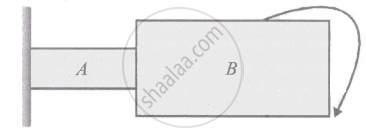Advertisements
Advertisements
Question
Two cylinders A and B of the same material have same length, their radii being in the ratio 1 : 2 respectively. The two are joined end to end as shown in the figure. One end of cylinder A is rigidly clamped while free end of cylinder B is twisted through an angle θ. The angle of twist of cylinder A is ______.

Options
`17/16 theta`
16 θ
17 θ
`16/17 theta`
Solution
Two cylinders A and B of the same material have same length, their radii being in the ratio 1 : 2 respectively. The two are joined end to end as shown in the figure. One end of cylinder A is rigidly clamped while free end of cylinder B is twisted through an angle θ. The angle of twist of cylinder A is `underline(16/17 theta)`.
Explanation:
Torque required to produce unit twist
T = `(pi"nr")^4/l theta`
`"T"_"A"/"T"_"B" = (("r"_"A")^4 theta_"A")("r"_"B"^4 theta_"B")` or, `theta_"A"/theta_"B" = ("r"_"B")^2/("r"_"A")^2 = (4"r")^2/("r"^2)` = 16
`therefore theta"A" = 16 theta_"B" = theta_"A"/16`
And according to question, `theta = theta_"A" + theta_"B"`
or, θ = `theta_"A" + theta_"A"/16 = 17/16 theta_"A"`
`therefore theta_"A" = 16/17 theta`
